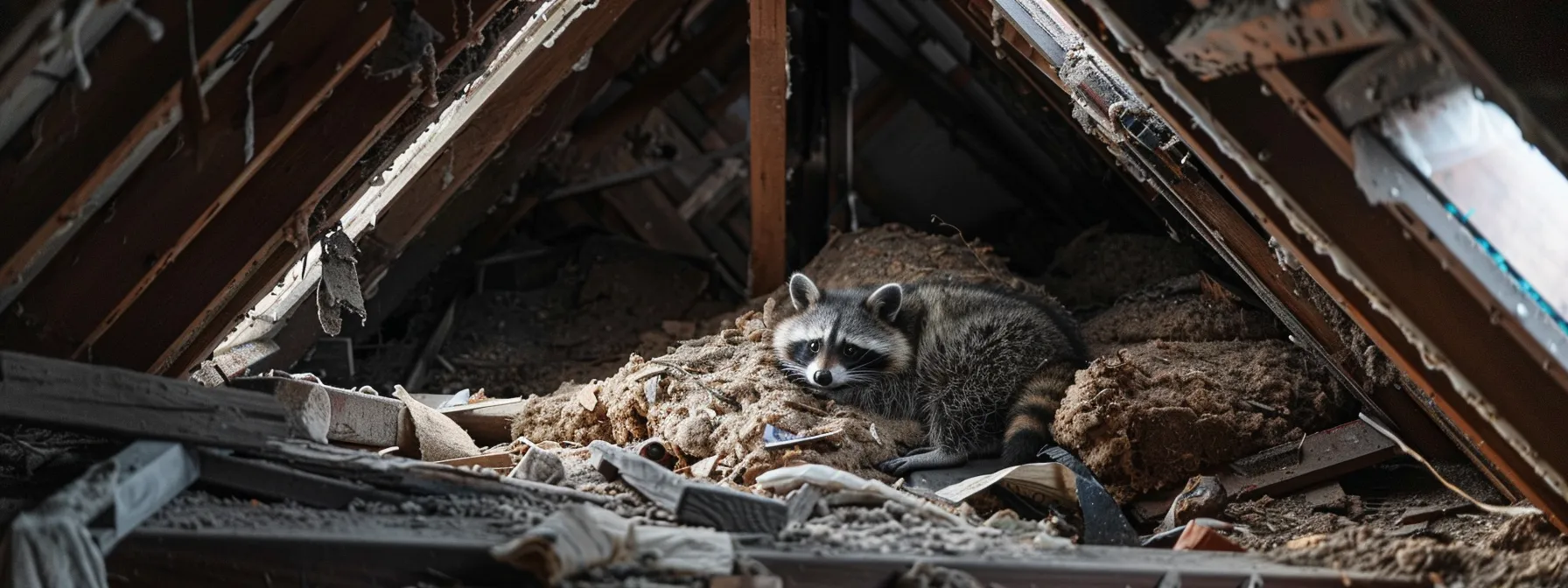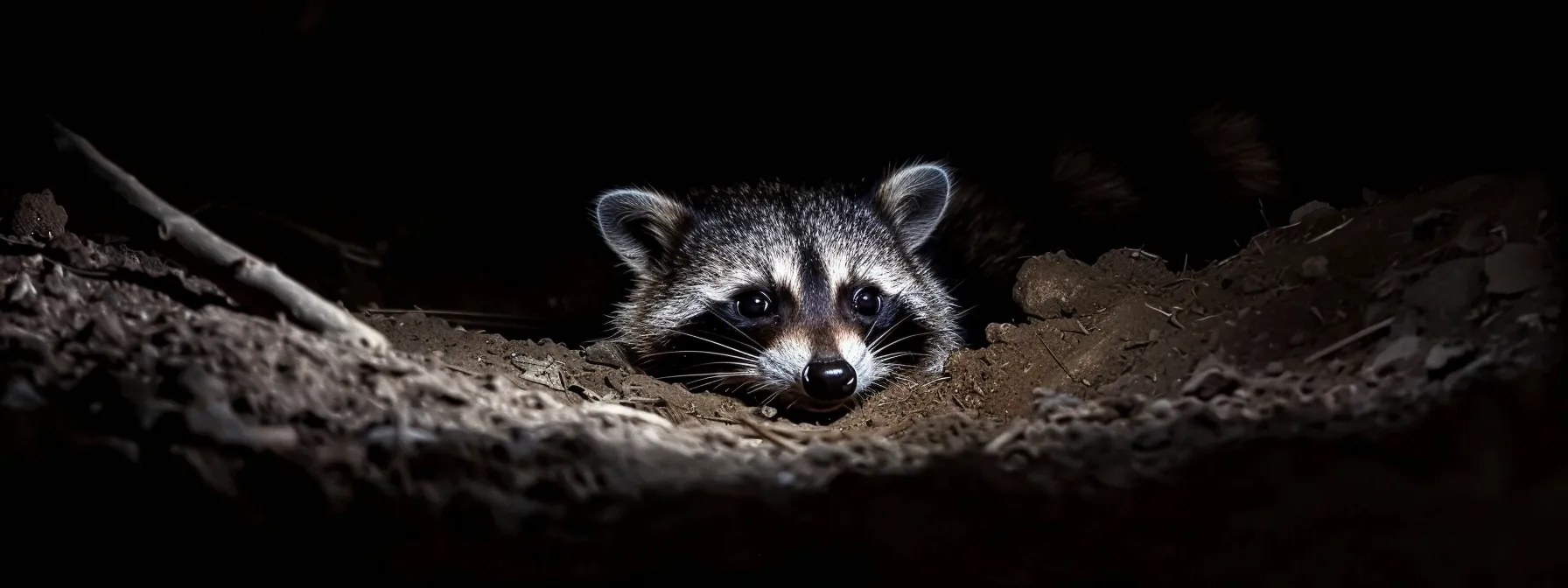
Raccoon Nesting Habits Revealed
Are raccoons intruding on your property and causing concern? Understanding raccoon nesting habits is essential for homeowners in Essex, Bergen, and Passaic Counties. This article will explore raccoonbehavior in their natural habitat, identify common types of dens, and highlight signs of their presence near your home. By engaging with this content, readers will gain valuable insights into preventing raccoon invasions and maintaining a safe living environment. Ultimately, this knowledge can help homeowners address pest control issues efficiently and effectively.
Understand RaccoonBehavior in Their Natural Habitat

Raccoons exhibit remarkable adaptability and resourcefulness within their natural surroundings. Observing how a motherraccoon collects food, scavenging pet food left outside, highlights their opportunistic nature. Common traits include their nocturnal activities and unique nesting habits, often found in attics or foliage, which can lead to conflicts, especially with skunks seeking similar habitats.
Examine How Raccoons Adapt to Their Surroundings
Raccoons demonstrate a high level of adaptability to various environments, which has allowed them to thrive in both rural and urban ecosystems. Their ability to alter their foraging methods effectively enables them to utilize available resources, such as compost bins and pet food left outdoors. Urbanization has expanded their territory, creating additional challenges for homeowners as these creatures seek shelter in areas like roofs or attics.
Their opportunistic behavior allows raccoons to excel in environments where others might struggle. By utilizing diverse nesting sites including tree hollows, shrubs, and human structures, they can find safety and protection from predators. Understanding the adaptability of raccoons is crucial for homeowners, as this knowledge assists in developing effective strategies for prevention and control in residential areas.
Identify Common Traits in RaccoonBehavior
Raccoons demonstrate distinct behaviors that set them apart from other wildlife, including opossums. They are primarily nocturnal, using the cover of darkness to forage for food with their nimble front paws. Their dexterous movements, coupled with a keen sense of sight and smell, enable them to raid trash cans and access pet food, making them efficient scavengers. Recognizing these behaviors is essential for property owners considering raccoon removal options, as it provides insight into how raccoons invade residential spaces.
Another notable aspect of raccoonbehavior is their reliance on their remarkable tails for balance and maneuverability while navigating trees and rooftops. As they search for nesting sites, they display a propensity for areas that offer both safety and shelter, often opting for attics and the hidden crevices of homes. Homeowners dealing with raccoons must understand these behaviors to effectively implement mosquito control measures and deter these inquisitive creatures from taking residence in unwanted locations.
Observe Their Nocturnal Activities and Impacts
Raccoons are primarily nocturnal, engaging in their most active foraging behaviors under the cover of darkness. Homeowners may notice these creatures scavenging for food, such as pet food left outside, and rummaging through trash cans. This nightly activity can result in property damage or exposure to disease, emphasizing the need for regular inspections of areas like chimneys and attics where raccoons might take shelter.
Their nocturnal habits are not just a behavioral trait but also a survival strategy, allowing them to avoid natural predators. During colder months, raccoons may enter a state of torpor, reducing their activity levels but still posing a risk to homes as they seek warm nesting sites. Homeowners must be vigilant about prevention measures to mitigate the impacts of raccoon presence and maintain a safe environment for their families.
Raccoons seek safety and warmth in their dens, hidden from the world. Understanding where they make their homes reveals much about their lives and habits.
Discover Different Types of Raccoon Dens and Their Locations

Raccoons demonstrate unique survival skills when selecting locations for their dens. They often favor tree cavities and abandoned burrows, providing natural shelter. In urban settings, raccoons are drawn to human structures, including attics and garages, which can create conflicts with homeowners. Exploring these nesting preferences is essential for effective wildlife control and understanding the potential presence of feces and other signs of urban wildlife.
Analyze Where Raccoons Prefer to Build Their Homes
Raccoons typically prefer to establish their dens in tree hollows, utilizing these natural cavities for shelter. In urban environments, they often adapt by seeking refuge in attics, sheds, and garages where they find protection from the elements and predators. This adaptability to human structures can lead to unwanted interactions, as raccoons may also be drawn to food sources such as bird feeders, creating potential conflicts for homeowners.
The presence of raccoons in residential areas raises concerns regarding health risks, such as transmitting baylisascaris procyonis, a parasitic infection linked to raccoonfeces. Homeowners should be vigilant in maintaining clean surroundings and securing outdoor food sources to deter raccoons from adopting their properties as preferred habitats. By understanding where raccoons choose to build their homes, property owners can implement effective strategies to prevent these animals from settling in unwanted locations.
Learn About Tree Cavities and Abandoned Burrows
Tree cavities and abandoned burrows serve as ideal nesting sites for raccoonspecies, providing them with shelter and protection from predators. These locations offer a safe environment for raccoons during hibernation or periods of inactivity, where they can conserve energy and stay warm. Understanding the body language of raccoons can provide insights into their nesting habits; for example, if they exhibit signs of aggression or curiosity, it may indicate that they feel secure in their chosen area.
Moreover, raccoons are known for their foraging skills, often venturing out at night in search of food. When they find suitable dens, these locations become central to their daily activities, including feeding and raising young. Homeowners can benefit from this knowledge by implementing preventative measures through services offered by above and beyond pest control, ensuring their properties remain free from unwelcome raccoon visitors.
Explore Human Structures That Attract Raccoons
Raccoons, as highly adaptable mammals, are increasingly drawn to human structures for nesting due to the shelter and resources they provide. Commonly, attics, garages, and basements serve as prime locations for these animals, where they can find safety from predators and ample food sources. This adaptability is often influenced by the human diet, with raccoons foraging for leftovers, pet food, and even insects that may be present in gardens, further solidifying their presence near residences.
The potential for animal welfare concerns arises when raccoons occupy spaces intended for human use, leading to conflicts. Homeowners must recognize that these mammals thrive in environments with easy access to food and shelter. Inspecting properties for entry points such as holes in foundations or tears in roofing can help alleviate issues before they escalate, promoting a safer living environment for both humans and wildlife alike.
As one studies the various den types raccoons choose, it becomes clear that their preferences are no accident. Understanding what drives their nesting decisions will reveal much about their behavior and habitat needs.
Recognize Factors Influencing Raccoon Nesting Choices

Seasonal changes significantly influence raccoon nesting choices, impacting the availability of food and shelter. Factors such as intelligence guide these animals to secure locations like basements and sheds that offer protection. Additionally, the presence of predators plays a crucial role in their decisions, as raccoons seek areas free from risks, ensuring their safety from potential threats and managing odors associated with nesting.
Investigate Seasonal Changes Affecting Nesting
Seasonal changes play a significant role in determining where raccoons choose to nest, as these animals seek out safe environments that provide shelter and food. During colder months, raccoons are inclined to occupy crawl spaces or basements to escape harsh weather conditions. Homeowners should remain vigilant, as these areas can harbor not only raccoons but also their fur and other signs of activity, indicating the need for pest control measures.
As seasons shift, the availability of food sources also influences nesting choices. In spring and summer, raccoons may take advantage of outdoor food options, leading them to establish dens in close proximity to residential areas. Property owners are encouraged to engage a pest control company for thorough clean-ups and to secure potential entry points to enhance their home’s protection from unwanted raccoon visitors.
Examine Food Availability and Shelter Security
Food availability plays a crucial role in determining where raccoons establish their nests. These creatures often seek out areas close to abundant food sources, such as pet food left outdoors or unsecured trash cans. Homeowners may experience increased noise and possible aggression from raccoons when they feel threatened while scavenging, highlighting the importance of securing food supplies to prevent unwanted wildlife interactions. In areas where raccoons are drawn for food, the risk of rabies exposure also increases, making it essential for property owners to exercise caution and consider prevention methods in their homes.
Shelter security is another significant factor that influences raccoon nesting habits. Raccoons are attracted to locations providing protection from predators and harsh weather conditions, such as attics or garages. This tendency can create conflicts with homeowners, leading to concerns over potential cruelty to animals during wildlife removal efforts. By understanding these behaviors, property owners can proactively address signs of raccoon presence and secure vulnerable entry points to protect both their living spaces and local wildlife. Regular inspections and preventive measures can further diminish the likelihood of raccoons choosing to nest in unwanted areas.
Assess the Role of Predators in Nesting Decisions
Predators play a significant role in the nesting decisions of raccoons, influencing their choice of locations that enhance safety and security. For instance, raccoons may opt to nest in areas that provide adequate cover from birds of prey or coyotes, ensuring their protection from potential threats. Understanding this dynamic is essential for homeowners, as it highlights the importance of creating an environment that minimizes attraction and reduces the risk of unwanted pests.
Moreover, the presence of nearby predators can dictate where raccoons establish their dens, pushing them to seek refuge in more sheltered spots such as attics or basements. This behavior underscores the necessity for residents to remain vigilant in securing their properties against raccoons, as well as to implement pest control measures that address both the raccoons and potential predators in the vicinity. By recognizing these factors, homeowners can take proactive steps to prevent raccoon infestations and protect their living spaces effectively.
Understanding where raccoons choose to nest is the first step to keeping one’s home safe. Next, it is essential to know how to act if these creatures appear near your living space.
Learn What to Do if You Encounter Raccoons Near Your Home

Understanding safe practices for coexistence with raccoons is essential for homeowners. This includes humane methods to deter these animals from nesting on properties while ensuring the safety of both residents and wildlife. In cases of persistent issues, knowing when to seek professional assistance can provide a long-term solution to managing raccoon presence effectively.
Understand Safe Practices for Coexistence
Homeowners can promote safe coexistence with raccoons by implementing key preventive measures. Securing trash cans and removing outdoor pet food minimizes the food sources that attract these animals. Properly sealing potential entry points around the property is crucial, as it reduces opportunities for raccoons to enter basements or attics, promoting a harmonious environment for both wildlife and residents.
If raccoons persistently approach residential areas, individuals should consider humane deterrents. Utilizing motion-activated lights or sprinklers can discourage nighttime foraging while maintaining the well-being of the animals. When faced with significant raccoon issues, consulting a professional pest control service, such as Above and Beyond Pest Control, can provide effective strategies tailored to local wildlifebehavior and ensure proper management of the situation.
Consider Humane Ways to Deter Them From Your Property
Homeowners seeking to deter raccoons can implement various humane strategies to protect their properties. One effective method involves securing trash bins with tight-fitting lids, as this minimizes access to food sources that attract raccoons. Additionally, removing pet food left outdoors during the night can significantly reduce the likelihood of raccoon visits, maintaining a safer environment for both residents and wildlife.
Furthermore, installing motion-activated lights or noise devices can effectively discourage raccoons from frequenting yards and gardens. These deterrents not only disrupt the raccoons’ nighttime activities but also promote a peaceful coexistence without causing harm to the animals. For persistent issues, homeowners are encouraged to consult with professionals, like Above and Beyond Pest Control, to develop tailored solutions that address local raccoonbehavior and establish long-term prevention techniques.
Know When to Seek Professional Assistance
Homeowners should recognize when a raccoon situation requires professional intervention. If a raccoon is discovered nesting in an attic or any other part of the home, it is essential to contact a pest control service like Above and Beyond Pest Control. Trained experts can assess the situation safely and implement effective strategies to remove the animal and prevent future occurrences, ensuring that the home remains a secure environment.
Additionally, if raccoons demonstrate aggressive behavior or frequent visits become an ongoing issue, seeking professional assistance is critical. Knowledgeable technicians understand raccoonbehavior and can offer tailored solutions that address specific challenges posed by these animals. Engaging a pest control service ensures that both the home and its occupants are protected while maintaining a humane approach to wildlife management.
Knowing how to handle a raccoon sighting is only part of the story. Next, recognize the signs that indicate these animals may be living nearby.
Identify Signs of Raccoons in Your Area

Homeowners can identify signs of raccoons in the area through several key indicators. Looking for distinct tracks and droppings can confirm their presence and activity levels. Signs of rummaging in yards, such as overturned trash cans or disturbed gardens, further suggest raccoons are exploring. Additionally, recognizing other wildlife sharing the habitat is vital, as it provides context for managing local pest populations effectively.
Look for Tracks and Droppings Indicating Presence
Recognizing raccoon tracks is essential for homeowners monitoring wildlife presence. Raccoons have distinct footprints characterized by five toes, resembling small human hands. These tracks often appear near garbage cans, gardens, or along pathways where raccoons might search for food, signaling their activity in the area.
In addition to tracks, raccoon droppings can provide helpful information regarding their presence. Typically thick and tubular, these droppings may contain remnants of seeds, fur, or other food items they’ve consumed. Finding raccoonfeces near potential nesting sites, like attics or sheds, can indicate that these animals are not just passing through but may be making themselves at home.
Recognize Signs of Rummaging in Your Yard
Homeowners can often identify signs of raccoon activity by observing disturbances in their yards. Typical indicators include overturned trash cans, scattered debris, and dug-up flower beds. These activities suggest that raccoons are exploring for food sources, making it essential for residents to monitor their properties for signs of rummaging.
Additionally, raccoons tend to leave behind clues such as paw prints or trails in soft soil or mulch. If gardens appear disturbed or if pet food is frequently accessed overnight, these could be clear signs of raccoon presence. Being aware of these signs allows homeowners to take proactive measures in securing their outdoor spaces and preventing unwanted raccoon visits.
Discover Other Wildlife That May Share the Habitat
Homeowners should be aware that raccoons often share their habitats with a variety of other wildlife, including opossums, skunks, and foxes. Each of these species has adapted to similar environments, leading to increased competition for food and nesting sites. Understanding the presence of these animals can help homeowners identify signs of raccoon activity, as well as other wildlife that may pose risks to gardens and outdoor spaces.
For instance, skunks may show similar signs of rummaging in yards, such as overturned trash cans and dug-up lawns, making it essential to recognize their tracks and habits. An understanding of the local wildlifeecosystem enables homeowners to implement effective deterrents and prevention measures, ensuring a harmonious living environment while addressing potential conflicts between animals. Recognizing these interactions fosters a proactive approach to wildlife management in residential areas.
Seeing the signs of raccoons can tell a story of survival. It is vital to grasp their role in the ecosystem and the efforts that protect them.
Explore Raccoon Conservation Efforts and Their Importance

Local initiatives play a critical role in supporting raccoon habitats while combating the challenges posed by urbanization. Understanding the effects of environmental changes on raccoon populations is essential for effective conservation strategies. Engaging in wildlife conservation efforts allows residents to contribute to maintaining healthy ecosystems, ensuring the well-being of these adaptable creatures while fostering coexistence with human communities.
Investigate Local Initiatives Supporting Raccoon Habitats
Local initiatives aimed at supporting raccoon habitats often focus on preserving natural environments that provide essential resources for these creatures. Community programs may include tree planting projects, which create additional nesting sites, as well as habitat restoration efforts that enhance food availability. Such initiatives not only benefit raccoons but also foster biodiversity, maintaining a balanced ecosystem that supports various wildlifespecies.
Collaborations between local governments, conservation organizations, and community members are crucial for implementing effective raccoonhabitat strategies. Educating residents about humane wildlife management and promoting practices that reduce human-wildlife conflicts become vital components of these efforts. By understanding raccoon nesting habits and the importance of their habitats, communities can take proactive measures to coexist peacefully while ensuring the well-being of these adaptable mammals.
Understand the Impact of Urbanization on Raccoon Populations
Urbanization significantly alters the habitats that raccoons rely on, leading to increased competition for nesting sites and food resources. As cities expand, raccoons adapt to human environments, finding shelter in attics, basements, and other structures. This adaptation often results in human-wildlife conflicts, making it essential for homeowners to understand these changes and implement preventive measures.
Moreover, urban development can disrupt natural migration paths and food sources, forcing raccoons to modify their foraging behaviors. Increased access to human waste and pet food creates a dependency on artificial food sources, potentially impacting their health and behavior. By recognizing how urbanization influences raccoon populations, communities can take active steps in wildlife conservation efforts, ensuring a balanced coexistence between residents and these adaptable mammals.
Learn How to Engage in Wildlife Conservation Efforts
Engaging in wildlife conservation efforts is essential for maintaining healthy raccoon populations and their habitats. Community members can participate in local clean-up activities that remove litter from parks and natural areas, which helps preserve the ecosystems where raccoons thrive. Collaborating with local organizations focused on wildlife restoration can also provide educational resources on humane raccoon management.
Property owners can further support conservation by creating wildlife-friendly spaces in their yards. Planting native vegetation and ensuring that outdoor trash bins are secure minimizes human-wildlife conflicts while promoting biodiversity. By fostering environments that accommodate both raccoons and other wildlife, communities can contribute to the welfare of these adaptable creatures and ensure their survival amidst urban challenges.
Conclusion
Understanding raccoon nesting habits is critical for homeowners aiming to prevent unwanted wildlife interactions. Recognizing their adaptability and preferences for human structures can inform effective prevention strategies that secure properties. By maintaining clean environments and addressing potential entry points, residents can minimize the likelihood of raccoon invasions. Ultimately, this knowledge fosters a safer living space while promoting coexistence between humans and these resourceful mammals.
